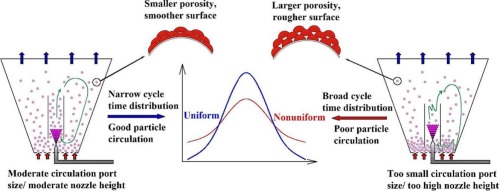Particle circulation and coating in a Wurster fluidized bed under different geometries

Abstract
The performance of particle coating is essentially determined by the morphology and uniformity of coating shells, which significantly depend on particle circulation. In this study, the geometry of a Wurster fluidized bed is changed by regulating particle circulation port size and nozzle position, and their effects on particle circulation and coating properties are investigated by combining coating experiments and CFD – Discrete Element Model (DEM). By increasing the circulation port size, the particle circulation rate first increases then decreases slightly, accordingly, the uniformity of particle circulation increases then decreases, while the shell porosity decreases. By increasing the nozzle height, the particle circulation rate decreases slightly, accordingly, the uniformity of particle circulation increases then decreases, while the shell porosity decreases. At extremes with a too small circulation port size or too high nozzle position, particle residence and cycle time distribution are broader, and an obvious nonuniformity of particle growth is observed.
Introduction
Particle coating is a mechanical process that forms a coating shell on the surface of solid particles, which is widely applied in the pharmaceutical, food, cosmetic, and fertilizer industries [1,2]. The particles with multiple coatings are manufactured by passing through the spraying and drying regions repeatedly [3]. The purpose of coating includes delaying drug release, particle surface modification, taste masking and the addition of active ingredients, and the necessary prerequisite for achieving the above functions is to ensure the coating uniformity [4]. However, particle motion in a spraying fluidized bed is complex, including collision between particles, heat transfer and drying, and other processes [5], which could result in the non-uniformity of the coating.
Extensive experimental studies have been conducted on particle circulation and coating properties. In the coating process of a Wurster fluidized bed, the cycle time distribution (CTD) and residence time distribution (RTD) of the particles are critical factors in determining the coating uniformity and particle growth [4], which are affected by equipment design and process conditions [6,7]. As the mass of bed material increases, the CTD becomes narrower, and the products quality is higher. Large particles have a longer cycle time than small particles [6]. The mean cycle time decreases and the CTD becomes narrower with the increase of the inlet air flow rate and the circulation port size between the central tube and the air distribution plate [8]. The circulation port size is reduced, and the volume of the spraying region is reduced. The increase of nozzle gas velocity will mainly shorten the residence time of particles in the spraying region. The reduced distance and increased gas velocity can speed particle recirculation in a fluidized bed [9].
Experiments were conducted to characterize the coating properties, including coating uniformity, the coating thickness distribution, coating shell porosity and coating shell morphology, through visual imaging analysis [7,[10], [11], [12], [13]], near infrared and Raman spectroscopy [[14], [15], [16], [17], [18]], terahertz pulsed imaging and optical coherence tomography [19,20], and X-ray microtomography [21,22]. In our previous study [23], the size of coated particles was measured by a microscope and image processing technology. It is found that the standard deviation increased in the coating process, indicating a gradual increase in the nonuniformity of particle size distribution.
The DEM model calculates the force, trajectory and growth of individual particles, which provides great details of the particle motion in granular systems [24]. Yamane et al. [25] calculated the movement of particles in a coating drum, and the residence time per pass in the spraying region was obtained. Li et al. [26] determined the particle cycle and residence time distribution in a laboratory-scale Wurster fluidized bed using the CFD-DEM model, showing that the residence time distribution of particles in the spraying region can provide valuable information about the final particle size distribution. Böhling et al. [27] used DEM model on the bed flow and coating uniformity in a large-scale fluidized bed coating, and found that the inlet velocity has the greatest influence on flow and uniformity. Ma et al. [28] developed a comprehensive CFD-DEM coupling model with changing liquid bridge force, mass and heat transfer to investigate the granule drying process in a fluidized bed dryer. In our previous study [24], the coating process in a spraying fluidized bed was simulated using the CFD-DEM model, and found that increasing the velocity and temperature of fluidized gas and reducing the coating solution spray rate properly can improve the uniformity of the coating.
Therefore, particle circulation in a spraying fluidized bed and coating properties were studied separately in the current research, but an understanding of the connection between the two is lacking. In this study, experiments and a CFD-DEM model are used to obtain rich data and discuss the relationship between particle circulation and particle coating properties in different Wurster fluidized beds. First, a short description of the particle coating experiment and CFD-DEM model is given in Section 2. Second, the experiments and simulation results are analyzed to obtain particle morphology, residence and cycle time distribution, particle size distribution and uniformity. Finally, conclusions about influence mechanisms of geometries on the particle circulation and coating properties are offered.
Read more here
Jinnan Guo, Daoyin Liu, Jiliang Ma, Cai Liang, Xiaoping Chen, Particle circulation and coating in a Wurster fluidized bed under different geometries, Powder Technology, 2023, 119223, ISSN 0032-5910, https://doi.org/10.1016/j.powtec.2023.119223.
Watch our webinar “Regulatory Considerations Regarding Immediate Release Film Coatings Post-Approval Changes in the U.S and Europe” here:


